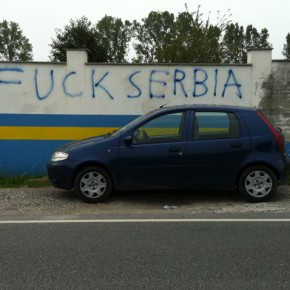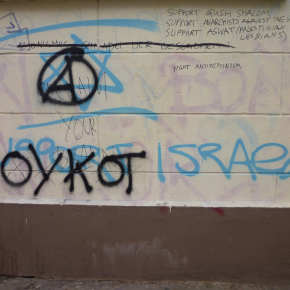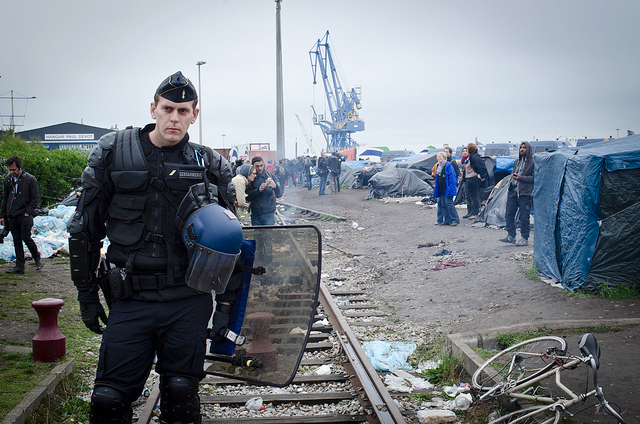The Green Wave, a new documentary directed by Ali Samadi Ahadi, tells the wired and informed what they already knew. It recounts the groundswell of support for Iranian presidential candidate and one-time Prime Minister Mir-Hossein Mousavi, whose chosen campaign colour of green gives the film, not to mention the historical event (The Green Revolution) its name.
Despite a high voter turnout for Mousavi, incumbent President Mahmoud Ahmadinejad was re-elected. Outraged, Iranians took to the streets in protest, expressing their frustration, alleging fraud. Demonstrators were met by a violent government crackdown, with protesters, many of them students, beaten, imprisoned, tortured and raped. The Green Wave captures the excitement and hope that lead to this revolt, the outrage that prompted the demonstrations, and the dismay and hopelessness in the face of a violent response to peaceful opposition.
What may be most interesting, however, is the manner in which The Green Wave incorporates the ways many of us first learned of these events. The film offers the expected archival footage and interviews with witnesses and authorities, including Noble Laureate Shirin Ebadi, Shi’ite cleric and critic of the Islamic Republic, Mohsen Kadivar, and human rights specialist Payam Akhavan. But mixed with this, the film (a self-described ‘documentary collage’) incorporates Twitter messages, video from cameras and mobile phones uploaded to YouTube, and excerpts from thousands of blog entries united and animated into a narrative of two students describing their experience of the Green Revolution, from their own political awakening to their imprisonment and eventual release.
This is not simply in keeping with the historical facts of the event, where media blackouts resulted in other modes of reportage. It also contributes to themes crucial to this story, including the role of new media in politics, and the challenges of testimony, particularly in the case of trauma. Equally significant, The Green Wave merges two types of public spheres: the virtual spaces of debate enabled through social media, and those of street politics. Early in the film, we are shown a pro-Mousavi rally, and the atmosphere is exhilarating. In part, the excitement comes from the by-now standard choices of political filming, which cut between wide shots of arenas followed by close-ups of the adoring fan.
This spectacle of mass worship had its introduction in Leni Riefenstahl’s The Triumph of the Will, but has since been replicated by political publicists and cineastes. This reference to Triumph of the Will helps acknowledge the cinematic origins of many similar events. (Indeed, excited as I was about Obama’s 2008 victory, I had to turn off the television when the pageantry of his acceptance and the masses shouting “Yes we can” in unsettling union reminded me too much of Riefenstahl’s film.)
At the same time, The Green Wave subverts the top-down nature of displays that elevate both the politician and the single auteur. The sequence begins with the testimony of a Mousavi campaigner, arriving early to set up. She is soon surrounded by volunteers who want to help and perhaps get a good seat as well. The story becomes one of a bottom-up development of this rally, a story of the people who attended, and their enthusiasm over the possibility of reform.
The Green Wave’s use of multiple blog entries, together with the Twitter feeds and YouTube videos, contributes to a voices-from-below aesthetic. There are many people coming together, not only to support a candidate, but also to provide their history. Here, the authoritative voice of experts and legacy media gives way to a wave of community voices, the central figures in this story of a civilian movement.
In this way, The Green Wave begins to represent a public sphere, a notion introduced by sociologist Jürgen Habermas to refer to spaces of discussion in which civil society can engage in politics, and hold the state accountable for its actions. Originally cultivated in literary salons, these new social spaces operated outside government control. However, new technologies have engendered new possibilities for political activities, by providing new communications resources to previously excluded groups. By including the voices of cyberspace, the documentary begins to unpack and illustrate a vibrant new space for Iranians, perhaps temporary, perhaps contingent, but there nonetheless.
The use of Twitter and YouTube, which became primary modes of communication following the Iranian government’s shut down of SMS text messaging, contributes to this portrait of a new discursive space for political mobilization. Interrupting the fictionalized narrative and the interviews are moments of complete blackout, where white text emerges, providing updates in fewer than 140 characters. The departure from the actual Twitter aesthetic is noteworthy. Although one could see this interruption as typical of Twitter, a demand to turn one’s attention to another platform, the simple text on a black background emphasizes both the media blackout of the context and the limitations of this strategy of representation.
The YouTube videos appear to offer more, with brief glimpses of demonstrations and violence. Included in the roster are those depicting Neda Agha-Soltan, the protester whose death was videotaped and circulated by bystanders, escaping the state media blackout to be broadcast on the Internet. Agha-Soltan and the video became a political rallying point outside Iran, creating global concern, bypassing the reach of a traditionally state-managed telecommunications system. At the same time, this footage, blown up for theatrical viewing, takes on a curiously impressionist effect, the enormous pixels challenging the photographic precision of the video that suggests its command over the representation of reality.
These limitations do not undermine the truth of the event or the truth-telling abilities of the documentary. Rather, these aesthetics aid in communicating the challenges inherent in documentary, which, while about the lived world, marshals cinematic strategies in the telling. Similar issues plague discussions of testimony, which as a first-person narration of suffering, inevitably rely on rhetorical and narrative strategies in order to present the event clearly and in a manner relatable to the audience.
Trauma further contributes to these issues, as trauma refers not only to an original violent event, but also to its impact on the psyche of a survivor. This is a memory that cannot be integrated into the narrative of one’s life, returning repeatedly and unbidden to haunt the present. Literary critics such as Cathy Caruth and Lawrence Langer have extended the discussion of trauma beyond the psychoanalytic, examining the ways literature can deliberately incorporate the lacunae forced into the psyche of survivors—a strategy that results in a fragmented and modernist aesthetic, one often favored by those dealing with representations of the Holocaust.
In this regard, The Green Wave performs the telling of a typically traumatic event. The grossly pixelated videos express the technological and psychological constraints of truth-telling. The animated sequences, which merge the testimonies of blogs with a fictionalised narrative, recall the documentary Ari Folman’s Waltz With Bashir, which uses performed testimony and animation to communicate the filmmaker’s struggle with a traumatic memory. It reflects an experience that is not wholly assimilated by its speaker/survivor.
Moreover, these aesthetics express the struggle to represent its subject matter, particularly in light of the Iranian government’s intense efforts to keep these events hidden from public view. In this way, they are in keeping with a stylistic tradition that is an integral part of Iranian cinema, typically rendered in the neorealist modes that blend fiction and documentary in order to bypass state restrictions by allowing fiction to veil critiques of reality.
It would be a mistake, however, to assume that The Green Wave’s style is just about trauma. It is also a complex counter-narrative to the official record of the Iranian state, consisting of many voices, one that suggests a public sphere’s capacity to inspire a successful civilian protest movement. Ali Samadi Ahadi does not dwell on the unknowability of this event, but instead explores the ways we’ve come to know it, the intersection of new media (Twitter, YouTube) with the old (documentary) and the relationship between virtual and political worlds. The question now is to ask, “What’s next?”
The Green Wave made its Israeli debut on July 3rd, at the Jerusalem Film Festival






1 comment